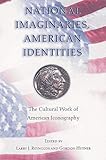National Imaginaries, American Identities : The Cultural Work of American Iconography / ed. by Larry J. Reynolds, Gordon Hutner.
Material type: TextPublisher: Princeton, NJ : Princeton University Press, [2022]Copyright date: ©2001Description: 1 online resource (248 p.) : 24 halftonesContent type:
TextPublisher: Princeton, NJ : Princeton University Press, [2022]Copyright date: ©2001Description: 1 online resource (248 p.) : 24 halftonesContent type: - 9780691227726
- Americains
- Arts and society -- United States -- History
- Arts et societe -- États-Unis -- Histoire
- Group identity -- United States -- History
- Identite collective -- États-Unis -- Histoire
- National characteristics, American
- Symbolism -- Social aspects -- United States -- History
- Symbolisme -- Aspect social -- États-Unis -- Histoire
- LITERARY CRITICISM / American / General
- American Ground Zero
- American Opinion
- Angel Face
- Anglo-African Magazine
- Art and Illusion
- Atomic Spaces
- Autobiography
- Billy Budd
- Democratic Review
- Double Indemnity
- Encyclopedia
- Enola
- Film noir
- Grandissimes
- Gunsmoke
- Harper's Weekly
- Hiroshima in America
- Little Lone Star
- Mildred Pierce
- Nation
- Othello
- Our Lives, Our Children
- Our National Parks
- Photography
- Picture Theory
- Politics
- Studies in Iconology
- Symbolism
- Touch of Evil
- Tribune
- Uncle Tom's Cabin
- ambivalence
- clergyman
- cultural iconography
- discursive processes
- effects
- fabulously textual
- her own
- hibakusha
- immemorial personage
- insomnia
- metapictures
- nautical Murats
- organization
- oversight
- patriarch
- phallic
- relationships
- seclusion
- vaquero
- 973 23
- E169.1 .N385 2000
- online - DeGruyter
| Item type | Current library | Call number | URL | Status | Notes | Barcode | |
|---|---|---|---|---|---|---|---|
 eBook
eBook
|
Biblioteca "Angelicum" Pont. Univ. S.Tommaso d'Aquino Nuvola online | online - DeGruyter (Browse shelf(Opens below)) | Online access | Not for loan (Accesso limitato) | Accesso per gli utenti autorizzati / Access for authorized users | (dgr)9780691227726 |
Frontmatter -- Contents -- List of Illustrations -- Acknowledgments -- Contributors -- Introduction American Cultural Iconography -- PART ONE: BETWEEN IMAGE AND NARRATIVE: FIGURING AMERICAN COLLECTIVITY -- CHAPTER 1 Seeing and Believing: Hawthorne's Reflections on the Daguerreotype in The House of the Seven Gables -- Chapter 2 Nuclear Pictures and Metapictures -- CHAPTER 3 Pittsburgh at Yellowstone: Old Faithful and the Pulse of Industrial America -- Chapter 4 Melville, Garibaldi, and the Medusa of Revolution -- PART TWO: REPRESENTATIONAL FRAMEWORKS AND THEIR OTHERS: THE POLITICS OF RACIALIZED GENDER AND SEXUALITY -- Chapter 5 Miscegenated America: The Civil War -- Chapter 6 The Whiteness of Film Noir -- Chapter 7 "Are We Men?": Prince Hall, Martin Delany, and the Masculine Ideal in Black Freemasonry, 1775-1865 -- Chapter 8 Unseemly Commemoration: Religion, Fragments, and the Icon -- Chapter 9 Tex-Sex-Mex: American Identities, Lone Stars, and the Politics of Racialized Sexuality
restricted access online access with authorization star
http://purl.org/coar/access_right/c_16ec
From the American Revolution to the present, the United States has enjoyed a rich and persuasive visual culture. These images have constructed, sustained, and disseminated social values and identities, but this unwieldy, sometimes untidy form of cultural expression has received less systematic attention than other modes of depicting American life. Recently, scholars in the humanities have developed a new critical approach to reading images and the cultural work they perform. This practice, American cultural iconography, is generating sophisticated analyses of how images organize our public life. The contributions to this volume exhibit the extraordinary scope and interpretive power of this interdisciplinary study while illuminating the dark corners of the nation's psyche. Drawing on such varied texts and visual media as daguerreotypes, political cartoons, tourist posters, and religious artifacts, these essays explore how pictures and words combine to teach us who we are and who we are not. They examine mimesis in elegant portraits of black Freemasons, industrial-age representations of national parks, and postwar photographs of atomic destruction. They consider how visual culture has described and disclosed the politics of racialized sexuality, whether subconsciously affirming it in the shadows of film noir or deliberately contesting it through the interethnic incest of John Sayles's Lone Star. Students of literature, film, and history will find that these essays extend the frontier of American studies. The contributors are Maurice Wallace, Dennis Berthold, Alan Trachtenberg, Shirley Samuels, Jenny Franchot, Cecelia Tichi, Eric Lott, Bryan C. Taylor, and José E. Limón.
Mode of access: Internet via World Wide Web.
In English.
Description based on online resource; title from PDF title page (publisher's Web site, viewed 29. Jul 2022)


